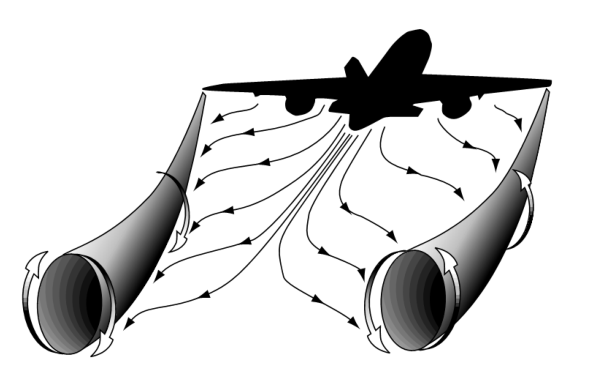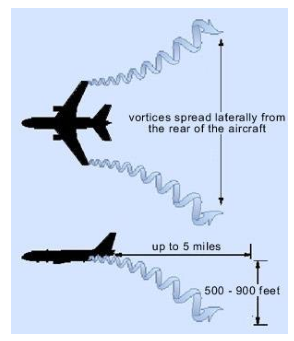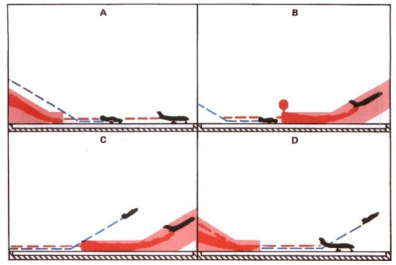¶ Definition and creation
Wake turbulence is turbulence that forms behind an aircraft as it passes through the air, causing wing-tip vortices.
Wake vortices are formed any time an air foil is producing lift. All aircraft produce wake turbulence.
Lift is generated by the creation of a pressure differential over the wing surface. The lowest pressure occurs over the upper wing surface and the highest pressure under the wing. This pressure differential triggers the roll up of the airflow aft of the wing resulting in swirling air masses trailing downstream of the wing tips. After the roll up is completed, the wake consists of two counter-rotating cylindrical vortices. This starts the wake vortex.

Wake vortices spread laterally away from the aircraft and descend approximately 500 to 900 feet at distances of up to five miles behind it. These vortices tend to descend at approximately 300 to 500 feet per minute during the first 30 seconds

Wing-tip vortices are stable and can remain in the air for up to three minutes after the passage of an aircraft, making it the primary and most dangerous component of wake turbulence.
¶ Effect when flying behind wake turbulence
The greatest hazard from wake turbulence is induced roll and yaw. This is especially dangerous during take-off and landing when there is little altitude for recovery.
Aircraft with short wingspans are most affected by wake turbulence.
Depending on the location of the trailing aircraft relative to the wake vortices, it is most common to be rolled in both directions.
The most dangerous situation is for a small aircraft to fly directly into the wake of a larger aircraft. This usually occurs while flying beneath the flight path of the larger aircraft. Small aircraft following larger aircraft may often be displaced more than 30 degrees in roll.
If the aircraft is flown between the vortices, high roll rates can coincide with very high sink rates in excess of 1000 feet per minute. Depending on the altitude, the outcome could be tragic.
Aircraft with smaller wingspans generate more intense wake vortices than aircraft with equivalent weights and longer wingspans. The Boeing 757, for example, has a relatively short wing and large power plant for the weight of the aircraft. The wake turbulence that is produced by the 757 is equivalent to that of a much heavier aircraft.
¶ Wake turbulence avoidance procedure
In order to avoid conflicts with wake turbulence, certain procedures are also observed by the pilots with regard to wake turbulence.
- Landing traffic will land beyond the touchdown point of the preceding aircraft. (A)
- Landing traffic will land prior to the departing aircraft's rotation point. (B)
- Departing aircraft will lift off (if possible) prior to preceding aircraft's rotation point. (C)
- Departing aircraft will lift off past the preceding aircraft's touchdown point. (D)

¶ Wake turbulence categories of aircraft
There are several wake turbulence categories depending on maximum take-off mass (MTOM) of the considered aircraft.
They are categorized by a letter in a flight plan L, M, H or J:
- L = Light = maximum take-off mass < 7000 kilograms (15,000 lb)
- M = Medium = 7000 kilograms < maximum take-off mass < 136,000 kilograms
- H = Heavy = maximum take-off mass >136000 kilograms (300,000 lb)
- J = Super = specific category for Airbus A380 (Jumbo)
For aircraft in the heavy (or jumbo) wake turbulence category the word Heavy shall be included immediately after the aircraft call sign in the initial radio telephony contact between such aircraft and ATS units
- ICAO Documentation 4444 - Air Traffic Management - 16th Edition 2016 - Chapter 4.9
- VID 150259 - Creation
- VID 150259 - Wiki integration
- VID 496402 - Wiki.js integration